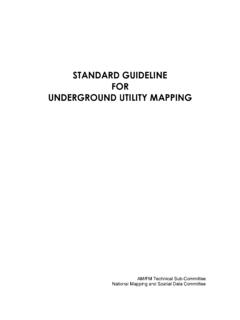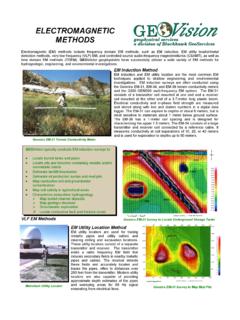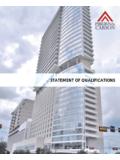Transcription of BROKEN WINDOWS AND QUALITY-OF-LIFE POLICING IN …
1 BROKEN WINDOWS AND QUALITY-OF-LIFE POLICING IN NEW york CITYWILLIAM J. BRATTONP olice CommissionerVIBRANT AND DENSE, New york city is inhabited by people from every continent and every coun-try, speaking every language in every accent, rep-resenting every culture and every creed. It orbits around eight million centers of the universe, as New york s poet laureate Billy Collins once wrote. Today that figure is closer to million, and doesn t include the additional millions who come each day, to work, or visit, or otherwise enjoy America s greatest city . Mayor Bill de Blasio and I have pledged to make a safer, fairer city for resi-dents and visitors alike, and this report describes one of the main tools for doing so: QUALITY-OF-LIFE POLICING .~PERHAPS EVEN MORE than Lady Liberty in the harbor, the subway pole is the symbol of this city . Every day, the city s diverse millions black and white, rich and poor, from Brooklyn or Bhutan, from Queens or Qatar cram into the tight con-fines of the country s busiest transit system.
2 Five and a half million people ride the subways every day, coursing through the metaphorical heart of New york . What the subway pole denotes is that this city works. In very crowded circumstances, five and a half million people six million on peak days go to work together and school together, sometimes squeezed shoulder to shoulder, and they do it in peace. Amazingly, there are fewer than six crimes a day on average. Because Ameri-ca s greatest city is her safest big city , as wasn t always I first came to this city in 1990, as Chief of the New york city Transit Police, the subways were a symbol of New york for a different reason. The underground graffiti, crime, and disorder were emblematic of an aboveground city that had become so parlous that it was driving America s crime rate. That year was crime s apogee and the city s nadir. In 1990, the city accounted for percent of the nation s population and percent of the nation s homicides and this at a time when the whole nation was more violent.
3 By 2013, those figures were percent and percent, respectively. The city , once the site of a tenth of the country s murders, now literally has less than its than any other factor, what caused this amazing change was BROKEN WINDOWS , or qual-ity-of-life POLICING . The term BROKEN WINDOWS comes from an eponymous 1982 article in the Atlantic, written by George Kelling and the late James Q. Wilson. In brief, Kelling and Wilson asserted that unaddressed disorder encourages more disorder. From that follows crime, then increasingly serious crime, and finally violence. This criminogenic progression existed irrespective of a neighborhood s demographics. As Kelling and Wilson wrote, Window-breaking does not neces-sarily occur on a large scale because some areas are inhabited by determined window breakers whereas others are populated by window-lovers; rather, one unrepaired BROKEN window is a signal that no one cares, and so breaking more WINDOWS costs nothing.
4 Beginning in 1990, I applied these ideas to crime in the New york city transit system. We wouldn t ignore the little things. Fare evasion and graffi-ti would no longer be considered too petty to address. In fact, we d focus on them as vigorously 1 THE NEW york city POLICE DEPARTMENT | 2015as on serious crimes like robberies, if not more so. Why? Because serious crime was more likely to occur in a lawless environment and ubiquitous low-level disorder signaled lawlessness even more than serious crime, which was less common. We also quickly learned that the serious criminals committed petty crimes, too. When they weren t committing robberies or assaults, they were hop-ping turnstiles, unlawfully moving between cars, and generally diminishing the quality of life that should have been enjoyed by other, fare-paying riders. A subway criminal arrested for a misde-meanor rather than a felony wouldn t be going to prison, but he wouldn t be victimizing anyone for a while, POLICING in the transit system worked.
5 From 1990 through 1993, crime rates underground fell by percent. In the city above, where QUALITY-OF-LIFE enforcement was less rigorous, it fell only s hard to overstate how counterintuitive this was in 1990. Observers, academics, and pundits had difficulty with the idea of concentrating on fare beating when felony violent crime was as predominant as it was. But we proved the conventional wisdom wrong, first in the transit system and then, starting in 1994, in New york city as a whole the first time I served as Police 20%10%20%30%40%-40%-30%-20%-10%-70%-60%- 50%05001,0001,5002,0002,5003,0003,5004,0 0019801982198419861990198819921994199619 982000200220042006200820102012 NYC Crime Rate and Misdemeanor Arrests% Above/Below 5- city AvgNYC Misdemeanor Arrest Rate per 100,000 NYC Crime Rate Relative to 5- city AvgIn order to put New york city 's crime decline in context, this chart displays New york city 'scrime rate the blue line as a percentage above or below the average of the state's five next largest cities (Albany, Buffalo, Rochester, Syracuse, and Yonkers)
6 The black zero that sits New york city s misdemeanor arrest rate per 100,000 residents, in Misdemeanor Arrest RateFigure A BROKEN WINDOWS AND QUALITY-OF-LIFE POLICING IN NEW york city Commissioner. With my leadership team partic-ularly Deputy Commissioner of Operations, the late Jack Maple, and Chief of Department, Louis Anemone we established the crime accountabil-ity system known as crime mapping and organizational account-ability practices, CompStat recreated, at the executive command level, the BROKEN WINDOWS philosophy of sweating the small stuff before it became the big stuff. The advent of QUALITY-OF-LIFE POLICING for the cops and management account-ability for the commanders amounted to a public safety revolution that was about more than fighting crime it was about preventing crime. A primary means of doing so was stopping low-level disorder and petty crime before they flourished and invited more serious chart on the previous page (Figure A) shows New york city s crime rate, in blue, as a percent-age relative to the crime-rate average of New york State s next five largest cities, which is the horizontal zero line.
7 Atop that sits New york city s misdemeanor arrest rate per 100,000 residents, in a mid- 80s peak and fall, the misdemeanor arrest rate gradually began to rise again in 1990. This was influenced by my adoption of quali-ty-of-life POLICING in the transit system, as our small force started taking back the platforms and the trains. When Mayor David Dinkins initiated his Safe Streets, Safe city program and increased the NYPD s headcount, the rate increased a bit more because there were more officers to make the arrests. But it wasn t until 1994, when I assumed leadership of the NYPD and brought QUALITY-OF-LIFE POLICING to the city as a whole, that we saw New york city s crime rate fall below the average of the state s next five largest cities. And compared to the crime rate of those other cities, which were not using CompStat and BROKEN WINDOWS , our crime rate just kept dropping, until New york city had nearly 60% less crime than its in-state frequent argument that New york city s crime decline was or is no greater than the regional or national decline is patently misdemeanor arrests ultimately led to few-er felony arrests because the NYPD was preventing crime more effectively.
8 By applying summonses to violations and arrests to misde-meanor crimes, rather than looking the other way because these offenses are too insignifi-cant, officers were correcting conditions early. Arresting someone for a misdemeanor frequently prevents him from graduating to committing felonies, for which severe sanctions like prison may result. That s why index-crime arrests are down 36% from 1994 (in 2014, there were 60,000 fewer felony arrests than there were twenty years ago). That s why the city jail population on Rikers Island was nearly halved between 1993 and 2013. That s why, from 1990 to 2012, New york city has sent 69% fewer people to state prisons (and it is the major factor in the state prison population declining 25% from 2000 to 2013). Misdemeanor arrestees don t go to prison, and they rarely go to jail. (See page 24.)NONE OF THIS means we can t explore alterna-tives to misdemeanor arrest.
9 We can and we are doing so. We can be more considered and more considerate. We can be more respectful and more respected and we will fact is that QUALITY-OF-LIFE polic-ing is not about the blind pursuit of arrests; it s about what it says it s about: the quality of life in this city . Critics of BROKEN WINDOWS regularly conflate it with zero-tolerance tactics, but I have never equated the two, nor does George Kelling, and neither did Jack Maple or James Q. Wilson. In their Atlantic article, while discussing order maintenance on public transportation, Kelling and Wilson noted that the enforcement need involve nothing more than ejecting the offender (the offense, after all, is not one with which a booking officer or a judge wishes to be bothered). What they were ac-knowledging was lawful police discretion, which the report that follows defines and discusses at length. (See page 11.)
10 In my view, BROKEN WINDOWS should be synon-ymous with discretion, not zero tolerance. In 3 Misdemeanor arresteesdon t go to prison,and they rarely go to NEW york city POLICE DEPARTMENT | 2015the first six months of my time with the Transit Department, cops issued 30 percent more sum-monses and made 80 percent more arrests, but they also more than quadrupled ejections from the system a non-criminal-enforcement mea-sure to control know that when someone s actions di-minish other people s quality of life, arrests and summonses aren t the only answer. BROKEN WINDOWS and CompStat were never and should never be about making them the only answer. At the same time, we also should never and must never retreat from enforcing the law. Discretion has limits. When we decline to offer a warning to recidivists people caught doing the same thing again and again, with multiple arrests and open cases that s not only lawful, it s sensible.
















